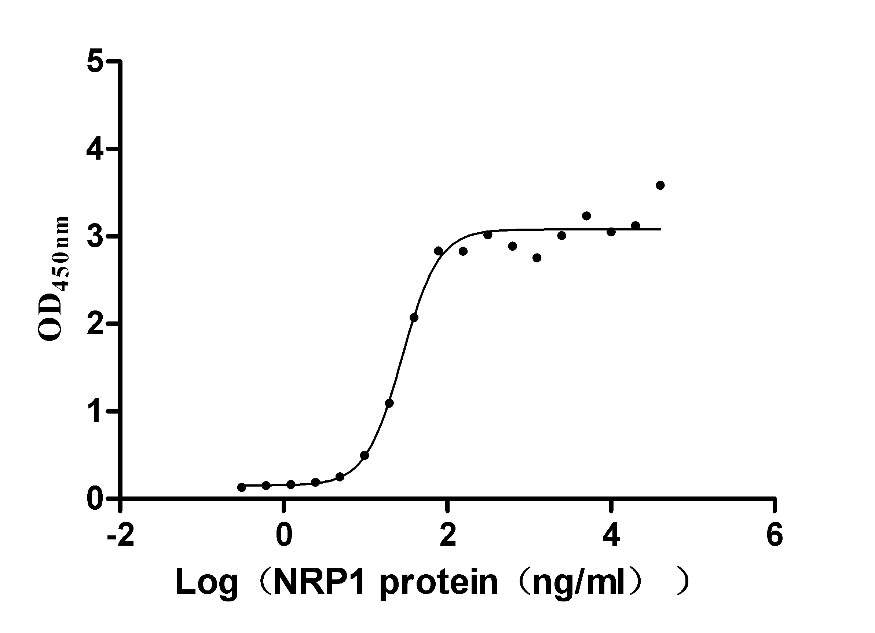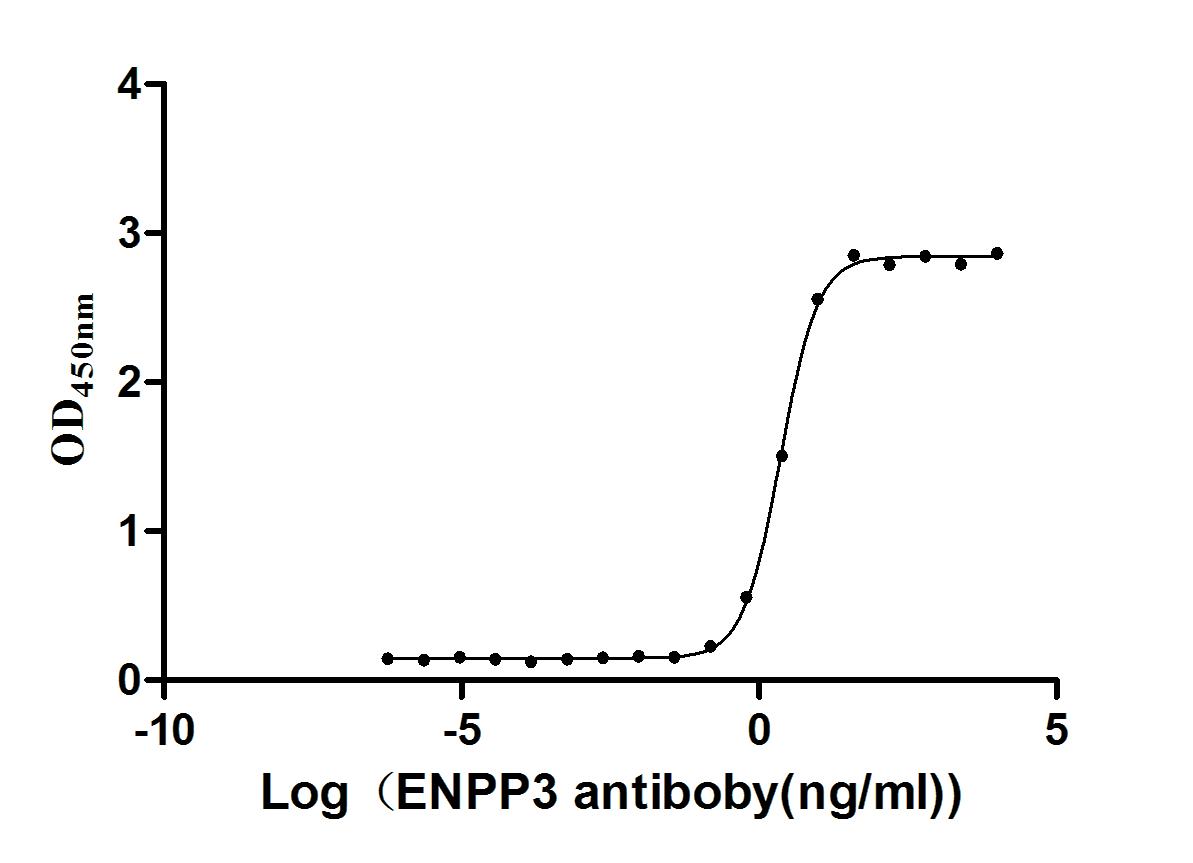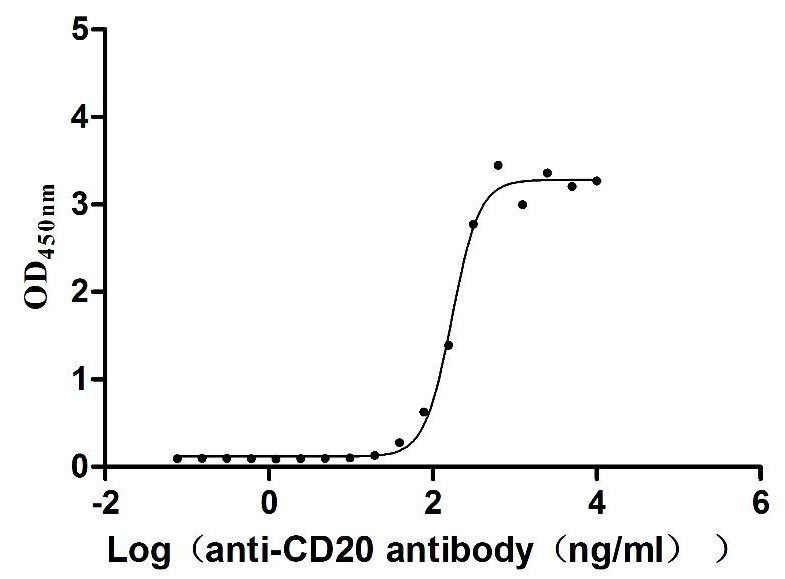Recombinant Bovine Growth/differentiation factor 8 (MSTN)
-
货号:CSB-YP015057BO
-
规格:
-
来源:Yeast
-
其他:
-
货号:CSB-EP015057BO
-
规格:
-
来源:E.coli
-
其他:
-
货号:CSB-EP015057BO-B
-
规格:
-
来源:E.coli
-
共轭:Avi-tag Biotinylated
E. coli biotin ligase (BirA) is highly specific in covalently attaching biotin to the 15 amino acid AviTag peptide. This recombinant protein was biotinylated in vivo by AviTag-BirA technology, which method is BriA catalyzes amide linkage between the biotin and the specific lysine of the AviTag.
-
其他:
-
货号:CSB-BP015057BO
-
规格:
-
来源:Baculovirus
-
其他:
-
货号:CSB-MP015057BO
-
规格:
-
来源:Mammalian cell
-
其他:
产品详情
-
纯度:>85% (SDS-PAGE)
-
基因名:
-
Uniprot No.:
-
别名:MSTN; GDF8; MHGrowth/differentiation factor 8; GDF-8; Myostatin
-
种属:Bos taurus (Bovine)
-
蛋白长度:Full Length of Mature Protein
-
表达区域:267-375
-
氨基酸序列DFGL DCDEHSTESR CCRYPLTVDF EAFGWDWIIA PKRYKANYCS GECEFVFLQK YPHTHLVHQA NPRGSAGPCC TPTKMSPINM LYFNGEGQII YGKIPAMVVD RCGCS
-
蛋白标签:Tag type will be determined during the manufacturing process.
The tag type will be determined during production process. If you have specified tag type, please tell us and we will develop the specified tag preferentially. -
产品提供形式:Lyophilized powder
Note: We will preferentially ship the format that we have in stock, however, if you have any special requirement for the format, please remark your requirement when placing the order, we will prepare according to your demand. -
复溶:We recommend that this vial be briefly centrifuged prior to opening to bring the contents to the bottom. Please reconstitute protein in deionized sterile water to a concentration of 0.1-1.0 mg/mL.We recommend to add 5-50% of glycerol (final concentration) and aliquot for long-term storage at -20℃/-80℃. Our default final concentration of glycerol is 50%. Customers could use it as reference.
-
储存条件:Store at -20°C/-80°C upon receipt, aliquoting is necessary for mutiple use. Avoid repeated freeze-thaw cycles.
-
保质期:The shelf life is related to many factors, storage state, buffer ingredients, storage temperature and the stability of the protein itself.
Generally, the shelf life of liquid form is 6 months at -20°C/-80°C. The shelf life of lyophilized form is 12 months at -20°C/-80°C. -
货期:Delivery time may differ from different purchasing way or location, please kindly consult your local distributors for specific delivery time.Note: All of our proteins are default shipped with normal blue ice packs, if you request to ship with dry ice, please communicate with us in advance and extra fees will be charged.
-
注意事项:Repeated freezing and thawing is not recommended. Store working aliquots at 4°C for up to one week.
-
Datasheet :Please contact us to get it.
相关产品
靶点详情
-
功能:Acts specifically as a negative regulator of skeletal muscle growth.
-
基因功能参考文献:
- GH/HpaII locus as candidate marker for body weight in cattle rather than MSTN/DraI. PMID: 29023020
- Data indicate that the the promoter trap vector PIII-myostatin could knock out the bovine myostatin gene. PMID: 25867424
- The effects of myostatin and myogenic factor 5 polymorphisms on growth and muscle traits of Marchigiana breed were assessed. PMID: 25023801
- we demonstrate zygote injection of TALEN mRNA can also produce gene-edited cattle and sheep. In both species we have targeted the myostatin (MSTN) gene. PMID: 25204701
- proof-of-concept study is the first to produce MSTN mutations in cattle, and may allow the development of genetically modified strains of double-muscled cattle. PMID: 24743319
- Mutations in the leader peptide of the bovine myostatin gene effectively promote the proliferation of bovine fibroblast cells. PMID: 24583167
- there were 18 SNPs identified in the Qinchuan cattle promoter region compared with those of other cattle compared to the Red Angus cattle myostatin promoter region. PMID: 24065681
- A 3-way interaction of myostatin genotype (MG), season, and trigonometric function periodicities of 24 h and 12 h indicate that a genotype x environment interaction exists for MG. PMID: 23572263
- These results show for the first time that myostatin regulates the differential expression of chemokines in skeletal muscle cells. PMID: 23838214
- bovine myostatin is a specific target of miR-27b and that miRNAs contribute to explain additive phenotypic hypertrophy in Piedmontese cattle selected for the MSTN gene mutation PMID: 23510267
- Mutations in the myostatin gene, responsible for the double muscling condition in cattle, were targeted to estimate the time since the most recent common ancestor. Each myostatin allele had a recent common ancestor (<400 years ago). PMID: 22497537
- MSTN promoter polymorphism g.-371T>A may affect carcass traits. PMID: 21743995
- Expressions of C-EBPalpha and myostatin in muscles were higher in the concentrate-fed group than in the grass hay-fed group. PMID: 21641731
- The sequence of the bovine myostatin gene promoter and first intron from Qinchuan and Red Angus cattle, was analyzed. PMID: 21125331
- the selection of the myostatin gene "+" allele has the potential to increase conventional milk production traits in the dual-purpose Belgian Blue breed. PMID: 21700058
- The I442M mutation in the NCAPG gene and the Q204X mutation in the GDF8 gene, were identified as substantial modulators of pre- and/or postnatal growth in cattle. PMID: 20647382
- extracellular matrix molecules may modulate myostatin activity PMID: 20163680
- mutations Q204X and nt821 affect carcass and meat quality PMID: 19966162
- Northern blot analysis revealed no appreciable change in myostatin mRNA levels between proliferating myoblasts and differentiated myotubes. PMID: 15975431
- Results suggest that myostatin auto-regulates its gene expression through a Smad7 dependent mechanism in myogenic cells. PMID: 16110474
- myostatin loss-of-function mutation affected several physiological processes involved in the development and determination of the functional characteristics of muscle tissue PMID: 17331240
- F94L genotype can produce an intermediate, non-double muscling phenotype, which should be of significant value for beef cattle producers. PMID: 17617213
- The results provide strong evidence that this myostatin F94L variant provides an intermediate and more useful phenotype than the more severe double-muscling phenotype caused by knockout mutations in the myostatin gene. PMID: 18245504
- Single-nucleotide polymorphism in the myostatin gene 5'-flanking region is associated with abnormal skeletal muscle growth and development. PMID: 18670060
- 11-bp deletion in the bovine myostatin was found at a low frequency (0.04) with no animals homozygous for the mutation in the sample population (536 animals)in a commercial population of Scottish Aberdeen Angus beef cattle. PMID: 18822096
- findings suggest that the endogenous myostatin preferentially down-regulates the expression of the fast 2x MyHC and participates in differentiation of myofiber types during early bovine myogenesis PMID: 18941308
- The objective of this study was to quantify the effects of the Charolais-specific inactive myostatin allele on phenotypic means and genetic parameters of heifer breeding traits. PMID: 19213706
- The gene expression pattern of inhibitory proteins related to MSTN signaling suggests a strong downregulation of this pathway in response to prolonged stretching. PMID: 19705480
- DNA sequencing revealed three, seven and four polymorphisms in exons 1, 2 and 3, respectively of the myostatin gene. PMID: 19731204
显示更多
收起更多
-
相关疾病:Defects in MSTN are the cause of the double-muscle phenotype or muscular hypertrophy (mh), an autosomal recessive disease frequently found in the Belgian blue and Piedmontese cattle breeds. This disease is characterized by an increased number of muscle fibers (hyperplasia), resulting in an increase in muscle mass of 20-25%.
-
亚细胞定位:Secreted.
-
蛋白家族:TGF-beta family
-
组织特异性:Specifically expressed in developing and adult skeletal muscle. Highest levels found in the hindlimb semimembranosus and biceps-femoris muscles; low levels in other hindlimb muscles.
-
数据库链接:
KEGG: bta:281187
STRING: 9913.ENSBTAP00000015674
UniGene: Bt.605
Most popular with customers
-
Recombinant Human B-cell receptor CD22 (CD22), partial (Active)
Express system: Mammalian cell
Species: Homo sapiens (Human)
-
Recombinant Human Neuropilin-1 (NRP1) (Active)
Express system: Mammalian cell
Species: Homo sapiens (Human)
-
Recombinant Human Tyrosine-protein kinase Mer (MERTK), partial (Active)
Express system: Mammalian cell
Species: Homo sapiens (Human)
-
Recombinant Human Nectin-4 (NECTIN4), partial (Active)
Express system: Mammalian cell
Species: Homo sapiens (Human)
-
Recombinant Human Intestinal-type alkaline phosphatase (ALPI) (Active)
Express system: Mammalian cell
Species: Homo sapiens (Human)
-
Express system: Mammalian cell
Species: Homo sapiens (Human)
-
Recombinant Dog B-lymphocyte antigen CD20 (MS4A1)-VLPs (Active)
Express system: Mammalian cell
Species: Canis lupus familiaris (Dog) (Canis familiaris)
-
Recombinant Human C-C chemokine receptor type 8 (CCR8)-VLPs (Active)
Express system: Mammalian cell
Species: Homo sapiens (Human)




















